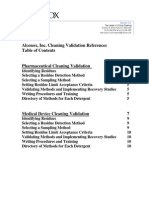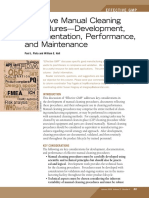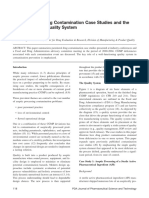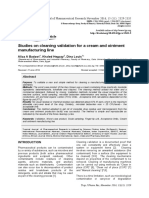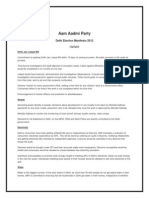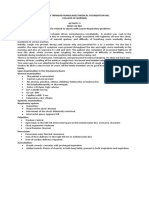Why The Swab Matters in Cleaning Validation
Why The Swab Matters in Cleaning Validation
Uploaded by
Yehuda Rahmanu PuteraCopyright:
Available Formats
Why The Swab Matters in Cleaning Validation
Why The Swab Matters in Cleaning Validation
Uploaded by
Yehuda Rahmanu PuteraOriginal Title
Copyright
Available Formats
Share this document
Did you find this document useful?
Is this content inappropriate?
Copyright:
Available Formats
Why The Swab Matters in Cleaning Validation
Why The Swab Matters in Cleaning Validation
Uploaded by
Yehuda Rahmanu PuteraCopyright:
Available Formats
Why The Swab Matters in Cleaning Validation
In recent years, increased emphasis has been placed on the development of validated and robust cleaning protocols.
Sandeep Kalelkar, Ph.D.
WHAT IS CLEANING VALIDATION?
The U.S. Food and Drug Administration (FDA) issued its Guide to InspectionsValidation of Cleaning Process1 in 1993. Since that time, the protocols surrounding cleaning processes in pharmaceutical manufacturing environments and sampling and filling suites have received increased attention.2,3 The primary regulatory concern driving the need for cleaning validation is crosscontamination of the desired drug substance either by other active pharmaceutical ingredients (API) from previous batch runs or by residues from the cleaning agents used. Cross-contamination with extraneous residues of any kind presents a safety risk to patients consuming the drug product. It threatens to alter the strength, chemical identity, and integrity of the drug substance and formulation. Therefore, the equipment and work environments involved in drug manufacturing processes must be cleaned at regular, prescribed intervals to prevent the possibility of such cross-contamination. These cleaning protocols must be validated in order to provide assurance that they do, in fact, serve their purposeto clean the surfaces to a level that avoids the possibility of cross-contamination. In recent years, increased emphasis has been placed on the development of validated and robust cleaning protocols given the concerns over the safety of our drug supply. Growth in the levels of outsourcing and off-shoring of pharmaceutical manufacturing has heightened the FDAs concern over cleaning processes. Inadequate documentation, training, and validation of cleaning processes rank high among the four most often cited problems in Form 483 and warning letters that have been issued by the U.S. FDA.4
WHY SWABBING?
In a typical pharmaceutical manufacturing environment, cleaning might be performed by using 70% isopropyl alcohol (IPA) and/or other chemicals, detergents, and sanitizing agents in order to remove residues from the previous batch run. The areas thus cleaned must now be sampled adequately and appropriately in order to validate the cleaning protocol. Swabbing and rinsing are the two most common techniques used for sampling of such cleaned surfaces. Swabbing is a direct surface sampling method, while rinsing is an indirect
Controlled Environments
www.cemag.us
December 2010
method. In practice, physical access to surfaces and parts of equipment to be cleaned tends to drive the choice of sampling method. For example, swabbing would work particularly well in more restricted work areas such as isolators, hoods, and accessible corners of equipment, while rinsing would work best in pipes and longer tubes. In general, a combination of both is most desirable in order to accomplish the most comprehensive coverage of surfaces to be cleaned. While the FDA guidance indicates a preference for the more direct swabbing method, more recent communication from the International Conference on Harmonisation (ICH) ICH Q7A5 states that sampling methods need to be comprehensive enough to quantitate both soluble and insoluble residues that are left behind on the surfaces after cleaning. The exact protocols prescribed will necessarily vary depending on the nature of the products, residues, and surfaces. These protocols must be tailored to the needs of each environment.
THE SWABBING PROCEDURE CONSIDERATIONS
The swab to be used for sampling is typically pre-wetted with water or another appropriate solvent in order to remove residues from the surface. Squeezing the sides of the swab against the inside of the vial upon pre-wetting prior to sampling removes excess solvent. This is important because excess solvent can itself serve as a source of residues leading to variable results. There is a direct, physical interaction between
the swab, the solvent, and the residues to be removed; therefore, the choice of swab is critical to the effectiveness of the sampling process. The swab used must offer ultra-low particulates and fibers, high absorbency, and minimal extractable interferences. Polyester swabs are specially processed to meet the stringent requirements associated with cleaning validation protocols. The physical nature of the swabbing process implies that significant levels of operator training be conducted prior to implementation of cleaning validation protocols. This training should serve to minimize the subjectivity that is inherent to such sampling activity. The recommended directions and motions used in actual swabbing of an area as shown in Figure 1 should be detailed in the training to ensure the highest levels of consistency. Alternate swab sampling patterns may certainly be used if they would help maximize percent recovery. A suitable extractable solvent is used to release the residues from the swab head. Depending on the particular SOP in each area, this swab sample may need to be filtered and/or sonicated to extract the residues as completely as possible. These sample prep procedures place a heavy premium on the intrinsic quality of the materials used in the swab head and the filters. The use of anything less than the highest quality of suitably pre-treated polyester swabs can prove to be a source of extraneous contamination in the subsequent assay. The method development and validation steps are often conducted on test coupons to serve as examples of the equipment or surfaces to be cleaned. The choice of filter and solvent used in sample preparation is also critical since they can have an impact on the recovery, influence extractables, and efficiency of filtration. Yang et al. have reported a systematic study of a variety of solvent conditions and pH and their impact on the percent recovery and efficiency of filtration.6 While it may be intuitive to choose the solvent conditions used in the subsequent analysis (e.g. HPLC) as the extractable solvent, this may sometimes compromise the filtering efficiency and the percent recovery.
Figure 1: Recommended directions and motions of swabbing.
Controlled Environments
www.cemag.us
December 2010
ANALYSIS OF RESIDUESANALYTICAL CONSIDERATIONS
The purpose of swab sampling as part of a cleaning validation protocol is to be able to prove that the cleaning process served its purpose. That purpose (cleaning the surfaces to avoid any cross-contamination) is best measured in the validation step as a percent recovery of seeded residue. Such a measurement provides an estimate of Residue Acceptable Limit (RAL). The measurement of percent recovery is accomplished through an analytical test, typically either HPLC (High Performance Liquid Chromatography) or TOC (Total Organic Carbon). HPLC-UV systems commonly carry additional detectors such as mass spectrometry (MS - for specificity and identification). It is important to realize early in the method development process for cleaning validation that percent recovery will be directly influenced by the interaction of the particular assay detector with each of the variables involved in the protocol. It is best to conduct a pre-study of the influence of the various factors involved in the cleaning in order to ensure that their effect on the final percent recovery measurement is well understood. It is typically very cumbersome to deconvolute an aberrant percent recovery result after-the-fact for a method that may have been in use over a long period of time. Cleaning Validation is a complex activity requiring a careful choice of sampling procedure and analytical method. It is therefore highly recommended to always use only the highest quality materials for swabs, filters, and solvents in cleaning validation protocols in order to assure that they cannot serve as sources of aberrant results, if and when those results do occur. Both HPLC and TOC are highly sensitive methods that serve as assays for cleaning validation protocols. HPLC by its very nature is a specific assay in that it can identify peaks and assign them to specific residues, while TOC is a classically non-specific measure of overall carbon burden in a given environment. Since these assays are both quantitative, typical analytical parameters such as accuracy, precision, linearity, detection, and quantitation limits must be evaluated as part of method development. While HPLC is a very commonly used tool in the pharmaceutical industry, the complexity, trace level sensitivity, and criticality of the cleaning validation protocol to drug safety merits special attention to the results from HPLC analysis. It is important to avoid
using materials that might serve as sources of contamination through interference with the UV spectrum, or the detector of choice. In the event that such interference in the assay is unavoidable, understanding and perhaps even quantitating the interference so that the cleaning validation protocol is appropriately sciencebased would pass muster under an investigation. Attempts should be made to identify any additional peaks that appear in the chromatograms of swabextracted samples besides those arising from the expected residues. TOC (Total Organic Carbon) is a conductometric assay that correlates with carbon concentration, which provides an overall, non-specific estimate of residue burden left behind on the surface from a previous batch run. TOC measurements are highly sensitive and typically reported at the part per billion (ppb, or g/L) level. As such, great care must be taken during the swab sampling and sample preparation to minimize external sources of organic carbon contamination.
SUMMARY
Cleaning validation is an essential step in the critical cleaning of pharmaceutical manufacturing environments. Swabbing is the preferred method of sampling such surfaces in the process of cleaning validation. The sampling and analysis methods have a direct and measurable impact on the percent recovery results from either HPLC or TOC assays. It is critical to ensure that the swab, filters, and associated materials used during the process are of the highest possible quality and do not contribute even trace levels of impurities that can interfere with the results.
References 1. Guide to Inspections of Validation of Cleaning Processes, FDA Office of Regulatory Affairs, Rockville, MD, 1993. 2. Carlson, J. Is swabbing a regulatory requirement? Journal of GXP Compliance, (14):1, 2010. 3. Pluta, P. and Sharnez, R., Avoiding Pitfalls of Cleaning Validation. Journal of GXP Compliance, (14):3, 2010. 4. McCormick, D. Poor OOS Review Leads Causes of FDA Citations. Pharma Technol. Oct 2005 5. ICH Guidance for Industry, Q7A; Good Manufacturing Practice Guidance for Active Pharmaceutical Ingredients, Aug 2001. 6. Yang, P, Burson, K., Feder, D. and Macdonald, F. Method Development of Swab Sampling for Cleaning Validation. Pharmaceutical Technology, Jan 2005. Sandeep Kalelkar is Director of Marketing for Texwipe, an ITW Company. www.texwipe.com
Reprint of copyrighted material courtesy of Vicon Publishing, Inc. and Controlled Environments Magazine . Go to www.cemag.us to sign up for a free subscription to Controlled Environments Magazine .
Controlled Environments www.cemag.us December 2010
You might also like
- Yang 2013Document9 pagesYang 2013Tanneru Hemanth KumarNo ratings yet
- Blend Uniformity AnalysisDocument16 pagesBlend Uniformity AnalysisUrsula Hille100% (1)
- Septimus Warren Smith As The Double of MDocument3 pagesSeptimus Warren Smith As The Double of MPriscila A. CustodioNo ratings yet
- Liquinox Cleaning ValidationDocument12 pagesLiquinox Cleaning Validationdnagent007No ratings yet
- Cleaning Validation For Biopharmaceutical Manufacturing at GenentechDocument4 pagesCleaning Validation For Biopharmaceutical Manufacturing at GenentechLisa Denysa SigarNo ratings yet
- Leachables and Extractables Handbook: Safety Evaluation, Qualification, and Best Practices Applied to Inhalation Drug ProductsFrom EverandLeachables and Extractables Handbook: Safety Evaluation, Qualification, and Best Practices Applied to Inhalation Drug ProductsDouglas J. BallNo ratings yet
- Cleaning and disinfection of food factories: a practical guideFrom EverandCleaning and disinfection of food factories: a practical guideNo ratings yet
- 2 3 Cleaning Validation Nairobi May 2011Document56 pages2 3 Cleaning Validation Nairobi May 2011Prashant MengshettiNo ratings yet
- Forced DegradationDocument8 pagesForced DegradationBiyaya San PedroNo ratings yet
- Effective Manual Cleaning Procedures-Development, Documentation, Performance, and MaintenanceDocument3 pagesEffective Manual Cleaning Procedures-Development, Documentation, Performance, and MaintenanceElena TrofinNo ratings yet
- The Future of Systems Validation ACF1D6Document3 pagesThe Future of Systems Validation ACF1D6Mitchel JammalNo ratings yet
- IVT Network - A Risk Matrix Approach For Media Simulation Trials - 2014-04-30Document11 pagesIVT Network - A Risk Matrix Approach For Media Simulation Trials - 2014-04-30vijayns_250355172No ratings yet
- Sutton - JGXP .14.3 PDFDocument9 pagesSutton - JGXP .14.3 PDFFaisal AbbasNo ratings yet
- ISPEDocument11 pagesISPEABHISHEK SHARMANo ratings yet
- Evaluation Study For Determination of Quantities of Disinfectant Solution Used For Fogging of Clean Rooms With Respect To Area VolumeDocument6 pagesEvaluation Study For Determination of Quantities of Disinfectant Solution Used For Fogging of Clean Rooms With Respect To Area VolumeSurjeet SamantaNo ratings yet
- 2risk MaPPandContainment PharmaForum2011 1Document35 pages2risk MaPPandContainment PharmaForum2011 1Steven LambertNo ratings yet
- Llenado Aseptico PDFDocument20 pagesLlenado Aseptico PDFLucia Rodriguez AguilarNo ratings yet
- IVT Network - Process Validation - 2014-04-28Document1 pageIVT Network - Process Validation - 2014-04-28Mina Maher MikhailNo ratings yet
- Guidelines On Bacterial Endotoxins Tests Version 2.0 20.01.2023Document16 pagesGuidelines On Bacterial Endotoxins Tests Version 2.0 20.01.2023Dhananjay BalghareNo ratings yet
- Preand Post IntegrityDocument29 pagesPreand Post IntegrityJaideep Katarey0% (1)
- Isolator Technology Workshop - Sterility Test Isolator: Engineering - Validation - OperationDocument4 pagesIsolator Technology Workshop - Sterility Test Isolator: Engineering - Validation - OperationRND BiotisNo ratings yet
- Limites Microbianos Por PoissonDocument10 pagesLimites Microbianos Por PoissonJavier GalvanNo ratings yet
- Headspace Oxygen Measurement in Vials and AmpoulesDocument4 pagesHeadspace Oxygen Measurement in Vials and AmpoulesGhanta Ranjith KumarNo ratings yet
- BFS-FRIEDMAN - Contamination Case Studies Paper PDFDocument9 pagesBFS-FRIEDMAN - Contamination Case Studies Paper PDFipatoffNo ratings yet
- 9 Temperature Mapping Mistakes To AvoidDocument5 pages9 Temperature Mapping Mistakes To AvoidReema IshaqNo ratings yet
- White Paper: EU GMP Guide-Annex 15 Qualification & Validation Draft ReleasedDocument17 pagesWhite Paper: EU GMP Guide-Annex 15 Qualification & Validation Draft ReleasedAhmad ZaidiNo ratings yet
- IVT Network - Sanitization of Pharmaceutical Facilities - 2014-08-29Document7 pagesIVT Network - Sanitization of Pharmaceutical Facilities - 2014-08-29Bhagath VikasNo ratings yet
- In and Outs of Prefilled SyreingesDocument10 pagesIn and Outs of Prefilled SyreingesvarunjaglanNo ratings yet
- SOP 08-IPEA Certification Criteria Rev 2Document55 pagesSOP 08-IPEA Certification Criteria Rev 2Farheen FurqanNo ratings yet
- 1229.13 Sterilization in PlaceDocument2 pages1229.13 Sterilization in PlaceWasimNo ratings yet
- Ejpps DeviationsDocument13 pagesEjpps DeviationsBlueSagaNo ratings yet
- Topic: CGMP As Per Who: PRESENTED BY: Dhruvi Parmar M.Pharm: 1 GUIDED BY: Khushbu Thakor DATE: 04Document30 pagesTopic: CGMP As Per Who: PRESENTED BY: Dhruvi Parmar M.Pharm: 1 GUIDED BY: Khushbu Thakor DATE: 04Dhruvi ParmarNo ratings yet
- Goverde ECAGuidelineDeviationofEMdatanon SterilesproductsDocument16 pagesGoverde ECAGuidelineDeviationofEMdatanon SterilesproductsIbrahim BouzinaNo ratings yet
- LyophilizersDocument6 pagesLyophilizersMohammed S.GoudaNo ratings yet
- Cleanroom Microbiology 101 Identifying Controlling Sources of ContaminationDocument4 pagesCleanroom Microbiology 101 Identifying Controlling Sources of Contaminationprakash deshmukhNo ratings yet
- Preparation of MFR in Pharmaceutical Industry.Document4 pagesPreparation of MFR in Pharmaceutical Industry.jaimurugesh100% (1)
- DCVMN Heat Sterilisation v3 1 PDFDocument94 pagesDCVMN Heat Sterilisation v3 1 PDFAnkush KharwalNo ratings yet
- Eguide: Contamination Control in Pharmaceutical IndustryDocument17 pagesEguide: Contamination Control in Pharmaceutical Industrygsv988No ratings yet
- 320 Other 1210 2 10 20180111Document10 pages320 Other 1210 2 10 20180111Vivek PrasadNo ratings yet
- Cleaning & Sanitization of Clean RoomsDocument3 pagesCleaning & Sanitization of Clean RoomsMd Saiful islam Bhuiyan100% (1)
- The Use of Risk Assessment Tools For MicDocument8 pagesThe Use of Risk Assessment Tools For MicYanNo ratings yet
- The Media Fill Approach An UpdateDocument3 pagesThe Media Fill Approach An UpdateajmalnasirNo ratings yet
- Aseptic ProcessingDocument13 pagesAseptic Processingnsk79in@gmail.comNo ratings yet
- Requirements For Hormonal Drug Manufacturing Facility: Submitted byDocument13 pagesRequirements For Hormonal Drug Manufacturing Facility: Submitted byMd. JewelNo ratings yet
- Using A PQRI Approach in Process ValidationDocument18 pagesUsing A PQRI Approach in Process ValidationmthilekkumarNo ratings yet
- Chapter Six Implementing GMP Programs: How Are The GMP Program Standards Organized?Document28 pagesChapter Six Implementing GMP Programs: How Are The GMP Program Standards Organized?Norita TjhinNo ratings yet
- Media Fill Indicador de ColorDocument6 pagesMedia Fill Indicador de Colorsteven correaNo ratings yet
- Autoclave ValidationDocument8 pagesAutoclave ValidationkushalNo ratings yet
- Studies On Cleaning Validation For A Cream and Ointment Manufacturing LineDocument7 pagesStudies On Cleaning Validation For A Cream and Ointment Manufacturing LinesppNo ratings yet
- QBD EMEA PPTDocument21 pagesQBD EMEA PPTElizabethValverde100% (1)
- The Top 70 Microbiology RegulationsDocument3 pagesThe Top 70 Microbiology RegulationsRudra RahmanNo ratings yet
- QBD Based Approach To Design Controlled Strategy For Wet Granulation Method Using Plackett Burman Design-Case StudyDocument7 pagesQBD Based Approach To Design Controlled Strategy For Wet Granulation Method Using Plackett Burman Design-Case StudyMarta Tovar AlbillosNo ratings yet
- Process Validation (Version 3)Document39 pagesProcess Validation (Version 3)AhckarawinThummaneeNo ratings yet
- Vapor Phase Hydrogen Peroxide ResistenceDocument5 pagesVapor Phase Hydrogen Peroxide ResistenceMohamed FetouhNo ratings yet
- IVT Network - Microbiological Assessment of Compressed Gases in Pharmaceutical Facilities - 2015-08-17Document7 pagesIVT Network - Microbiological Assessment of Compressed Gases in Pharmaceutical Facilities - 2015-08-17Youstina PhillipeNo ratings yet
- Examenul de Bacalaureat 2008 Proba E/F Proba Scris La Limba Englez L1 - Intensiv 3-4 Ore Subiectul I (30 Puncte) Varianta 038Document2 pagesExamenul de Bacalaureat 2008 Proba E/F Proba Scris La Limba Englez L1 - Intensiv 3-4 Ore Subiectul I (30 Puncte) Varianta 038andreeas17stefNo ratings yet
- Wound Irrigation 21.Document18 pagesWound Irrigation 21.Juice Wrld 999No ratings yet
- Organon Homoeopathy HistoryDocument1 pageOrganon Homoeopathy HistoryAnjum AbbasiNo ratings yet
- D.K. Joshi vs. State of U.P. and AnrsDocument12 pagesD.K. Joshi vs. State of U.P. and AnrsShakshi MehtaNo ratings yet
- Surgical Management of Coronary Artery DiseaseDocument41 pagesSurgical Management of Coronary Artery Diseaseapi-19916399No ratings yet
- Managing OCD: Doctor Discussion GuideDocument3 pagesManaging OCD: Doctor Discussion GuidedevNo ratings yet
- Skill Training For Swallowing Rehabilitation inDocument9 pagesSkill Training For Swallowing Rehabilitation invaleria posadaNo ratings yet
- CB GraphDocument7 pagesCB GraphSudhir BansalNo ratings yet
- Manual Autotrol Performa 263-268 Logix740-760 enDocument78 pagesManual Autotrol Performa 263-268 Logix740-760 enJuan Pablo Arango SolanoNo ratings yet
- Carcinoma Pancreas: Risk Factors: (A) Demographic FactorsDocument4 pagesCarcinoma Pancreas: Risk Factors: (A) Demographic FactorsSakthi Annamalai.cNo ratings yet
- Karle Vario Brochure Web PDFDocument38 pagesKarle Vario Brochure Web PDFMithil RayNo ratings yet
- AP Human Geography Unit 2 Population NotesDocument23 pagesAP Human Geography Unit 2 Population NotesJosh BatNo ratings yet
- Aam Aadmi Party - Manifesto CruxDocument4 pagesAam Aadmi Party - Manifesto CruxDesh KapoorNo ratings yet
- WVSU College of Medicine Full Website InfoDocument11 pagesWVSU College of Medicine Full Website InfoMiguel MansillaNo ratings yet
- Uses of LipidsDocument3 pagesUses of LipidsChris Ian AgustinNo ratings yet
- Thesis ReportDocument57 pagesThesis ReportShreya MirpagarNo ratings yet
- Prediction For The Adsorption of Low-Concentration Toluene by Activated CarbonDocument16 pagesPrediction For The Adsorption of Low-Concentration Toluene by Activated CarbonBong SomvixayNo ratings yet
- Covid Patient DetailsDocument7 pagesCovid Patient DetailsSr. Section Engineer Coaching Depot-ValsadNo ratings yet
- Dolo PlusDocument1 pageDolo PlusRami ElnakatNo ratings yet
- RA 10742 SK Reform ActDocument13 pagesRA 10742 SK Reform Actmemvi_7467% (3)
- Individualized Intensive Interventions:: Determining The Meaning of Challenging BehaviorDocument83 pagesIndividualized Intensive Interventions:: Determining The Meaning of Challenging BehaviorBejanNataliaNo ratings yet
- Something The Lord MadeDocument6 pagesSomething The Lord MadeAPESicaiNo ratings yet
- The Picture Below Shows How To Navigate Through The Course. Button To Begin. Press TheDocument48 pagesThe Picture Below Shows How To Navigate Through The Course. Button To Begin. Press TheSajjad AhmadNo ratings yet
- 2nd Case Scenario BronchitisDocument5 pages2nd Case Scenario BronchitisKasandra Dawn Moquia BerisoNo ratings yet
- Implant Placement and Loading Protocols in Partially Edentulous Patients: A Systematic ReviewDocument29 pagesImplant Placement and Loading Protocols in Partially Edentulous Patients: A Systematic ReviewSelman Yılmaz ÇiçekNo ratings yet
- Management of Sports InjuriesDocument35 pagesManagement of Sports InjuriesabdulazizmochammadNo ratings yet
- Ib 1Document146 pagesIb 1kanishkaNo ratings yet
- Test Bank for Foundations of Mental Health Care 6th Edition by MorrisonDocument40 pagesTest Bank for Foundations of Mental Health Care 6th Edition by Morrisonjudepogba1No ratings yet
- Patient ManagementDocument101 pagesPatient ManagementRhutvi ViraniNo ratings yet



